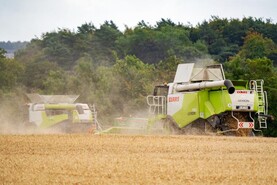Store cattle throughout the country continue to be in high demand, despite numbers forward at marts up significantly on the year.
Much of this increase is due to a backlog in marts following the closure during lockdown amid COVID-19.
While some marts were quick to get back up and running using online systems, the spring peak still didn’t start reappearing until June and is continuing into July.
Many farmers also showed some hesitation in buying stock early last month, with fear of grass shortages given drought conditions in some parts of the country.
The rain over the past few weeks has now rectified any deficits and buyer confidence is back in full swing.
Higher numbers
Looking at the numbers, data from the Irish Farmers Journal Martbids shows that cattle numbers at marts are 67% higher than seen at this stage of the year in 2019.
With such an increase, one would expect a drop in prices, but they are incredible high for the summer months.
Comparing the data, we see average prices for heifers across the weight divisions is between 10c/kg and 14c/kg higher than in 2019.
In steers, it’s a very similar story, with 400kg to 600kg bullocks up over 10c/kg, while lighter and fit steers have seen an increase of 20c/kg or more on the year.
Weanling bulls are up by 5c/kg for lighter stock, but numbers remain too small for heavier bulls and weanling heifers to give a fair reflection.
On the week
The dry cow trade remains very strong, with the average sale price increasing a further 3c/kg to €1.53/kg, having already increased by 4c/kg last week.
This is helped greatly by Northern Irish buyers continuing to purchase younger continental R and U grade cows.
Some marts have reported that 20% to 30% of dry suckler cows are being acquired by this market, with the right type breaking the €2.00/kg mark in cases.
Average sale price for the top third of cows sold remains at a solid €1.80/kg.
This demand also helped to boost the suckler trade, which saw a 50% increase in numbers, with prices rising by over €100/head to settle at €1,355.
Again younger, more continental-type cattle dominated this section, with over €2,000 seen on occasions.
Calf age was another determining factor, with those early spring continental-sired calves demanding a premium.
Calf trade
Calves forward at marts halved again on the week, with only big dairy areas reporting any significant numbers.
Looking at the data, we see big increases in both male and female calf averages. However, this is an unfair reflection, due to the increase in the number of reared calves forward.
Kilkenny Mart hosted the biggest numbers forward (see report below).
Cattle trade
As seen in the table, lighter steers weighing between 350kg and 400kg saw another increase on the week.
On average, the sale price rose by 16c/kg to settle at €2.09/kg.
Increased prices were seen across the weight divisions, but generally held that average of between €2 and €2.10/kg.
It’s a very similar story on price in the heifer rings, with a slightly higher price to be had for lighter lots.
Top-quality steers and heifers continue to dominate prices, reaching over €2.50/kg for special lots, but generally the €2.30/kg to €2.45/kg range is easily achieved for better-quality continental lots.
On the weanling side, numbers are still small in relation to other cattle, but cattle prices remain strong for this time of year.
There was a slight surge in the numbers of lighter weanling bulls, with demand equally as positive.
Bulls between 200kg and 300kg sold for an average price of over €2.50/kg, while the top third of lots in this section sold for an average price of just shy of €3/kg.
Numbers remain small in heifer weanlings weighing in excess of 400kg, so the small numbers in the analysis isn’t giving a fair reflection of trade.






 This is a subscriber-only article
This is a subscriber-only article










SHARING OPTIONS: